It's nearly 33 years since the invention of 'Pong' and the beloved coin-op arcade machine. Video games will go down as the most popular form of entertainment of the latter part of the 20th Century and beyond. In the video game heyday of the early 1980's, there were one and a half million games being operated on 350,000 sites in the US alone - and at least the same again for the rest of the world. These pages are written by a self confessed vid-kid and game freak and will cover the times from my first credits in the late 1970's, through the boom and bust period, the emergence of TV and handheld games right up to the present emulation scene with the likes of the fantastic MAME project which has enabled us old-timers to relive those halcyon days.
Leaving my gleaming Raleigh Chopper outside a chip shop as a twelve year-old was not an easy thing to do let me tell you. As I carefully locked the back wheel through the spokes and around the frame, I glanced through the grease-smeared window to see a huddle of schoolmates engulfing a white cabinet. I sauntered into the shop to be met by Kev (my mate and fellow Chopper owner), looking over my shoulder only four or five times at the bike. He'd finally got me parted from it to cast judgement on "this new invaders game in the chippy". What I saw on that bleak autumn evening in that Birmingham chip shop in 1979 has remained with me ever since.....for it was......Galaxian !
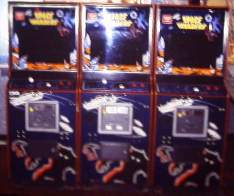
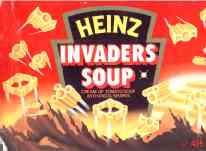
|
|
SPACE INVADERS - Who in the western world isn't familiar with those two words? The craze swept the entire globe back in 1978. That big blue cabinet. The Yeti on the side. Those were the days. One of the reasons for my vivid recollections of THAT piece of woodwork was because you'd invariably end up staring at it for twenty minutes before it was your turn in the queue! I reckon I could still freehand sketch, right now, the classic cabinet decals down to the last tiny detail. Taito, an arm of Bally/Midway the pinball makers, was the name behind the masterpiece which came complete with black and white monitor, green and purple overlays which enhanced the extremities of the playfield and a mirror to propel the images onto a decent background! Brilliant! The end result was the most exciting and challenging video game ever conceived and it instantly broadened the age group and mixture of arcade patrons forever. Great rows of the things were set up in the big arcades - and still those earthlings had to queue! To this day, nothing has struck more fear into a player than when the invaders went green! The sweat on the brow. The white knuckle on the joystick. The next credit. The 600,000 games sold globally not only revitalised the industry but proved to be a complete change of direction and an inspiration for many games to come. The pre-Space Invaders years consisted mainly of quirky and cult games - nothing leapt out at the player. Space Invaders broke the shackles. Nowhere was it bigger than in it's country of origin, Japan. More than half the games ever sold stayed in Japan. The national mint was forced into overtime to keep pace with the 100 Yen coin shortage generated by the game and supply outstripped demand as hundreds of entrepreneurial cafe owners changed all their tables to the table-top versions of Space Invaders! Arcade operators rigged up huge external speaker systems outside their crammed businesses to blast out the famous 'dum, dum, dum, dum' as the entire nation embraced the idea of shooting little white aliens from the sky with a little green tank. the game itself has all the essential qualities of a classic. Space Invaders was exciting, was challenging, was easy to operate and above all was highly addictive. A few hidden secrets soon manifested themselves and were exploited by the new breed of arcade heroes. The first one to surface was the old 'shot counting' ploy where the player counted 23 shots fired from his tank. The 24th produced a flying saucer worth the maximum 300 pts and thereafter, every 15 shots did the same! This counting routine made a mockery of the 'random' saucer bonuses but added another dimension to the already difficult task of prevent the Invaders from landing. This spawned one of the most important arcade commandments : "Thou shalt not disturb a player whilst on the count". There was also the celebrated 'safe spot' on the screen where the advancing aliens couldn't harm your tank. A rarer sight though was the so-called 'line trick' which would have been an impossibility for all but the most extraordinarily skilled player. According to various sources, it was put there by Taito to salute only the most gifted player. It was more likely a rumour started to boost the game's latter years. The arcade gossip went something along the lines of either shooting the top left invader first or shooting the bottom line of invaders LAST to complete the card. You'd then be privileged to some vertical lines which were then erased to make way for a 1,000 pt bonus! It's hard to believe that the programmer would have wasted precious memory and machine code on this idea when he couldn't even afford background graphics, the few bytes required to add another digit to score capacity or even to enter your name after achieving the high score. However, thanks to MG, here is the expose on the myth... "Take note that this is the Space Invaders Part II game. I don't believe that this trick resided on the original game. There are two possible reasons for this - either it came out on Part II and people talked about it as if it were a trick for the original or it became such a widespread rumor that the programmers gave the people what they wanted in Part II !" "Shoot all invaders while leaving one on the bottom leftmost corner for last....receive 1,000pts bonus and fireworks show OR shoot all invaders while leaving any other one on the bottom row for last....receive 800pts bonus and fireworks show OR shoot all invaders while leaving any one on the second to bottom row for last....receive 500pts bonus and fireworks show". As the games became full-blown workhorses and bits started to fall off them, some interesting improvisations on the hardware side were provided by the operators desperate to keep the machines going. Screwdrivers and pool balls were substituted for joystick knobs and on another occasion at a seaside pier I had a rather short game trying to manipulate a huge football-sized handle posing as a control. There were two types of controls for Space Invaders - the left/right button combination and the rarer aforementioned joystick . It's unclear why the joysticked variety stayed mainly overseas and Europe had most of the buttoned ones. The Japanese obsession with cleanliness may be a factor but I favour more the chance that they ran out of one or the other as demand escalated way beyond what the company envisaged. After a while, the dedicated invader blaster became too good for the machine, sending the score over the 9,990 regularly and back to zero.......enter Space Invaders DeLuxe/ Part II. With its more colourful images and the addition of a saucer which flashed, it made its U.S. debut in late '79. DeLuxe had the invaders splitting into two after being hit and reinforcements being dropped from the saucer making thing pretty hectic out there at times but alas, it could never emulate the tremendous success of its predecessor. Rumours of another trick lived on in Deluxe in the form of some spectacular rainbow but proof was hard to come by again (see above!). Further incarnations included Super Space Invaders,Space Invaders' Revenge and Space Invaders '91. |
 |
| In
its later days, Galaxian gained a somewhat
unjustified reputation as a 'boring' game but for me it still stands
proud as a real one-to-one challenge of a players' concentration. Its
uncomplicated controls and repetitive waves wore all but the most
robotic and machine-like players down. The game was obviously a close
relative of the mighty Space Invaders and
was introduced to the previously black and white world of video gaming
in October 1979 by Midway. Programmed by Namco of Japan, Galaxian with
its technicoloured little bugs flying down towards a beefed up shooting
tank, known strangely as a 'ship', eventually outstripped many of the
popular titles in earnings. The way the bugs flew around and sometimes
circled you before going off the screen to come back at the top was
absolutely captivating. Midway churned out huge numbers of this great
game but unfortunately so did 30-odd other companies! This
counterfeiting dented the prolific earnings for the makers as did the
rip off of Pacman a few years later and in the arcades of the UK, it
became a bit of a quest to actually find an original let me tell you! As
a result, the Galaxian devotee was able to
choose between versions which had swerving bullets, more bonus chances
and games with or without a fuel limit. The Galaxians were an absolute
must for the endurance player and the perfectionist element. Exact
movements of the ship and ultra-precise shooting combined with the
skills already honed on Space Invaders to allow the expert to rack up
many thousands of those worshipped commodities - points! The game
manufacturers were also learning. This time the score was able to
display a monumental 100,000 or more and the amount of screens or waves
completed were signified by a small red flag at the base of the screen -
always good news for the statisticians among us as we calculated
projected wave aggregates and averages galore! I'll never ever forget
the first time I saw the big red '10 flag'...I nearly passed out! The
flags did have a limit though - after the 48th flag (four 10's
and eight littlies) no more could be displayed! The experienced
campaigner could get their own back on the game though by exploiting a
safe loop in the program. If you fancied a break in proceedings or
wanted to show off your masterful domination of the game, it was
possible to lure the last surviving bug into a top of screen loop where
it could not harm your ship by dropping bullets on it or by one of those
famous suicide missions. Unfortunately as it yielded no points at all,
it was of little use unless you needed to eat, drink or take a toilet
break during an epic game!
|
|
DEFENDER Challenging. Intriguing. Captivating. Frustrating. The most exhilarating video game of all time. I should leave it at that but just can't. I mean, this is the game that changed the course of my life. There's no doubt that Defender changed the lives of myself and M.P.S. dramatically. We made great companions because of it, had unparalleled entertainment because of it, part time jobs at the arcade because of it and even girlfriends and wives because of it. December 1980 saw the culmination of Williams', one of the world's major pinball producers, most concerted effort to obtain a footing in the up and coming video game boom market. In its pre-release hype it was hailed as "the most technologically advanced video game ever created" and was. With more than 50,000 Defender sales, Williams' became America's third largest game producer virtually over night! The game had 256 colour graphics, an imposing black cabinet and most of all fantastic gameplay and unparalleled manoeuvrability of its ship yielding many industry awards for that year. The game was the plight of a spaceship rescuing humanoids from a planet surface deep in another solar system. If it wasn't for the pods, mutants, landers, bombers, swarmers and dreaded baiters, then it would have been a walkover. Technically, Defender offered the highest resolution colour images to date with a mammoth 80K of computer power backed up with an incredible array of software self-test, bookkeeping and hardware test modes. manuals, wiring diagrams and charts...the lot! Head engineer Ken Fedensa and ex-Atari man Eugene Jarvis had created such a masterpiece that demand for those unmistakable big black cabinets outstripped production. Williams' first video since 1977 and heralded as the most complex yet, eventually sold 55,000 units worldwide. The 26K of coded data was twice that used by other game makers and testament to the skill of the programmers in the days when there wasn't an endless amount of RAM and ROM at their disposal. The main processor was of about the same power as the one sitting in a tv remote nowadays and after all that, they still had room for a ladder of eight best scores of the day and eight of 'all time'. The screen scanner was amazing and the horizontal flight simulation and control of the ship perfect. The players just couldn't get enough of it. Yet again, more queuing for your brief bout of defending your digital planet. With the 'Hall of Fame' screen guaranteeing immortality for weeks on end, one single game (maybe that next credit?) could catapult your three initials from obscurity to instant superstardom. Those who fought through the crowds and parted with more credits got their name up two or three times on the table ensuring nothing but worshipping from other arcade-goers! Forget 'Today's greats' everybody longed to be an "All Time Great". Like all good games of the day, Defender wasn't short of computer eccentricities. It might have been a great game but one of the most obvious oversights go to the Williams team. A 'Lander' was valued on the attract mode at 100 pts but really worth 150 and the mock scores on the two ladders put up when the game was first switched on, would have been impossible to achieve as they ended in multiples of 10 and 15 (DRJ - 21,270) whereas real play enabled only multiples of 25. These were big issues of the day, OK? In their defence, it's possible that the conflict in scores would have freaked the machine out so they were messed with deliberately and it's actually the game that mistakenly gives 150 pts for shooting a Lander.....who knows?....who cares? Not surprisingly, devotees of the great game eventually got their rewards but it was a long and arduous apprenticeship fraught with heartache. You either loved or hated the arcade's hardest game. It certainly was an awesome sight for the first timer. Confronted by seven very important buttons and a joystick, some gave up after 75 humiliating points while others gave it one look and decided Galaxian was a better idea. To become any good at all on Defender it would take literally hundreds of precious credits - not to mention hours! There was no set pattern to be exploited and each game was different in its own way. Getting on the thing was also a bit of a worry. Defender's popularity meant coins would pile up on the control panel awaiting use by their owners (you just couldn't risk putting it in case, as was not uncommon with these fickle beasts, the machine decided to go haywire). My first encounter with Defender was as above described - humiliated for a paltry few hundred points. Back onto Asteroids. The following year at the same arcade I saw some dude get 99,000 pts. The adulation he was receiving was amazing. I was sold. A year older, more experienced on the games and in a better financial position than ever, this was going to be it I told myself. I'd be worshipped from all corners of the globe, young girls with enormous breasts would swoon and follow me everywhere, hanging on my every word........Two weeks later and with my holiday money nearly gone the only way I got my name up in the top eight was by being first on the machine at 9am only to watch the second player - at 9:03am, knock it off with ease. A few months later a machine dubiously titled "Defence Command" appeared in the local chip shop to much personal rejoicing. At first, serious doubts of whether I'd ever make in excess of 6,000 pts came to mind but with plenty of credits and time on our side, K.P.H.and I discovered an extra ship at 10,000 pts! From that moment in time our sole objective in life was to make it to the "All Time Greats" score card. We'd engage in hour long discussions on tactics, draw out scenarios and daydream of six-figure scores and all that adulation from fellow chippyers. We'd even break into a sprint as we neared the chip shop! Many blisters and weeks later I became that hero by holding all the top eight best scores! - a day I shall never forget. Just walking into a chip shop now with the fat bubbling away and the glorious aroma of frying fish brings it all flooding back. The 88,375 pts that sat proudly ontop of seven other "GUS'S" that December evening remains one of the greatest moments of my life! It was a sad Saturday indeed the day the machine blew up..............but we found others. The beauty of Defender and its relative longevity over other releases of the time lay with the numerous settings available to the operator. When players began to notch up big scores, the difficulty and/or extra ship level could be tweaked slightly to compensate. You see, with Defender a completely new set of tactics were required in accordance with the availability of the extra ships and alternative strategies employed with the changing of humanoid restoration waves. Top players reaching 990,000 pts found themselves treated to extra men for each point the scored - making it all the more harder to destroy your last man on 999,975 pts to register the maximum on the high score table. Even when Defender was outmoded by the new breed of games in 1984/5, its full potential had still not been reached. As a result there are few people who have ever played a game on its hardest settings, let alone got a decent score on one! This is where I must pay tribute to the Defending genius of my gaming sparring partner M.P.S. A late starter in about 1982, his unnatural ability seemed like mega slices of luck to us old hands but over time the scores spoke for themselves and we ended up having to admit that, yep, he was not only better than us - he became "THE BEST THERE EVER WAS". We've spent great chunks of our lives on Defender the two of us. In the end we were so honed to each other's gameplay that we'd share the controls to get a quick million between us just to show off! The hardest games always resided in Dayvilles (to our knowledge) and it was there that after three years hard labour and taking the Defender crown from the great MAT Stone, M.P.S. achieved what was thought to be the impossible - even to this day! He clocked the Defender on it's maximum difficulty and most soul-destroying setting with a miserly 20,000 pt bonus! The roar from the semi circle of onlookers as he got to 980,000 and then the unbelievable sight of 999,975 pts next to his name will stay with us until we are both old, old men I'm here to tell you. We'd both wonder occasionally out loud to each other about who could be any better and who exactly was the best Defenderer in the world but sadly we never found out. The US held the only competitions to our knowledge and such events in the UK were unheard of I'm sorry to say. Bert Jennings In the U.S. amassed 76,000,000 pts in what has to be one of the best endurance games ever. We know how he got the score but how on earth did he stay awake for 60-odd hours? I've been playing Defender since 1981 on a regular basis and during the course of those thousands of credits and thousands of hours and of course billions of points, I have discovered many special qualities in Defender and some not-so-special ones. So from my neatly kept 'Defender Diary', established in 1981, I'm going to disclose some of my secret findings and most guarded trivia as they happened to this 15 year-old.......(please take note of Chad's expert reasoning).......... The laser sound freaks out quite regularly / Saw 99 credits clocked up / Game came on backwards / Extra man music caused bombers to disappear / No red colour on a pier machine - swarmers were just yellow dots / A loaded memory makes aliens disappear / Mutants turn back over the large mountain / Maximum baiters on a screen is 18 / Swarmers turn back over mountain as well / A purple vertical line appeared on a game / The entire control panel came off in my hand / Found out there was no handle on a machine I'd put a credit in at Blackpool / Clocked Defender!!!! - 1,026,075 - score zeroed, no name up Two landers picked up one humanoid / Defence Command started grounding humanoids mid-screen for 500 pts / Hyperspace is delayed when memory is loaded / K.P.H. killed the maximum 18 baiters on screen - wave 1 / Killed by an invisible swarmer / Defence Command locked up never to return / MAT Stone got the top score of 300,000 pts at Dayvilles / Played MAT at doubles / Humanoids sometimes appear @ top of screen if enough are dropped / MAT's record is 6 hours - 6,000,000+ GUS/KPH = 4,500,000 pts / Short threaded rod used as a handle / Defence Command had all high scores as "???,???" - couldn't enter name for 999,975 / saw a female score 180,000 / Motionless swarmer killed me / Landers can get frozen in one position, low down, sometimes below the landscape Hyperspace and smart bombs can go off by themselves / Survived lightning strike on Jaywick arcade while on Defender - all games out / Played on a machine with a massive external bass speaker / Uncatchable humanoid just kept dropping around the screen / Enemy bullet went through my ship / Permanent fog appeared on screen after smart-bombing / Clocking a 20,000 pt extra game means the free extras start at 980,000! / Defence Command gave eleven humanoids / Swarmer exploded on hyperspace re-entry / Scored 999,975 on Defence Command giving extra ships at 17,350pts / Got 100,000 on a rip off game with a gun handle and impossible button layout / Got 250 pts for a humanoid dropped from the top of the screen / MAT reckons pressing hyperspace madly before the next wave might re-arranged the following pods in a group for a perfect smart bombing clearance / MAT is wrong / Blackpool game had a joystick for thrust and fire / Hyperspace 'blackspots' cause instant death on re-entry? / Can't play due to blisters on reverse thumb / RAM failure brought on by a furious game between J.C.R. and M.P.S. in Dayvilles / M.P.S. put up "AAA" for 999,975 pts / Defence Command replaced "GUS" & "MPS" on All Time Greats with "GUC" & "MQS" / Scored 984,000 pts @ Walsall Fair arcade -owner switched game off on us / M.P.S. had total audio failure at 950,000 pts / Filled the 'All Time Greats' :- 1 MPS - 999,975 2 GUS - 999,975 3 MPS - 999,975 4 GUS - 999,975 5 MPS - 999,975 6 GUS - 999,975 7 MPS - 999,975 8 GUS - 999,975 Shot 99 baiters on wave 1 / Dropping all ten humanoids always freezes the screen if there's no ship motion / M.P.S. beat MAT !!!!! / Scored 120,000 pts on machine with no reverse button / 140 baiters shot on wave 1 / Got 224,000 pts first man / Defence Command gave 5 pods / Made it from 300,000 to 999,975 pts in 'space' / Record 58 mins to reach 999,000 pts and had to kill off 110 men to get name up / Screen moved up losing the scanner and showing colour bars at base / Attack wave 256 took 4 hours - games goes back to wave 1 afetr 'wave 0' / Spent an hour and half for an end score of "0" as last man killed sent score over / thrown off by security at 300,000 pts in Candy arcade, Blackpool / Best ever shared game with MPS:- Defender Million.....The Ultimate Game : 0 - 355,000 = MPS - 387,000 = GUS (32,000) - 423,000 = GUS (36,000) - 496,000 = GUS (73,000) - 522,000 = MPS (26,000) - 552,000 = GUS (30,000) - 554,000 = MPS (2,000) - 584,000 = GUS (30,000) - 637,000 = MPS (53,000) - 682,000 = GUS (45,000) - 874,000 = MPS (192,000) - 882,000 = GUS (8,000) - 928,000 = MPS (46,000) - 935,000 = GUS (7,000) - 999,975 = MPS (65,000) (MPS scored 739,000) MAT - 190,000 pts first ship @ Dayvilles / KPH - 300 consecutive baiters shot giving 72,000 pts on 1st wave in Dayvilles / MAT - 200 baiters shot on one attack wave / Trebled an arcade record in Worthing with 608,000 pts - 15,000 extra / Clocked in 63 waves - no smarts or hyper used - killed off 115 men in 25 minutes / Found a mega hard machine - Modification Kit? - 20p play - speeds up madly after the 4th attack wave, two man start, no extras given, highest previous score was 19,000 ....... M.P.S. scored 28,000 pts / MPS clocked Dayvilles on hardest settings (62 waves), all settings level 99 but 30 is max / Blackpool game = 2p credit / M.P.S. - 1,000,000 in Dayvilles and gave game to MAT - final score 1,300,000 pts / Dayvilles now on 30,000 extra, level 30 difficulty / Defender converted to Nemesis in Dayvilles!!!! What a black-armband day that last entry was. By that time, though, both of us had got our own Defender machines so suicides were avoided but it did mark the end of all competitive playing for the few die-hards left around in 1985. Before the Defender chapter is closed, I must tell you about the time GUS and M.P.S. attempted a 10,000,000 pt marathon. It was in 1985 and Blackpool central pier was the venue where we'd noticed that the sole Defender was well out of view from the change kiosk as we'd both been thrown off machines dozens of times for being too good. As it would be around 10 hours of playing time we stayed the night and made for the arcade as early as possible trying not to look too suspicious. It was 10:09 when we started. We knew that if the security or management found out the takings for the day on Defender was only 10p we'd surely be barred for life. We split the first million to warm up our reflexes and while doing so had the first disaster. The fire button came flying out, spring and all, and onto the floor where we grovelled around for a few traumatic second and then struggled to push it back in the hole without losing too many ships. At first it wouldn't go and then it started working again - PHEW! It was really difficult now though to prevent it shooting out again with the frantic firing which is second nature to all vidiots. Despite the calamity, we passed the critical 256th spare ship in storage which cancels them all out, and leaves you with NO men until the next extra - and we were still making good time. Then came the 256th smart bomb and after a dinner and toilet break each, we came to the 256th attack wave which reverts the game back to the first card. All was going well. We'd been in training for this for years and it was going to become our greatest moment and something to tell our grandkids about - the time we stayed on Defender ALL DAY for 10p. With not so much as a twinge or ache in our highly toned forearms and firing fingers, we'd reached the 294th attack wave and 4,082,000 pts in just over 4 hrs 35 mins. Then it happened. Our efforts thwarted in a millisecond. To our utter dismay the game momentarily froze, the monitor went blank and....oh NO!...the game reset! 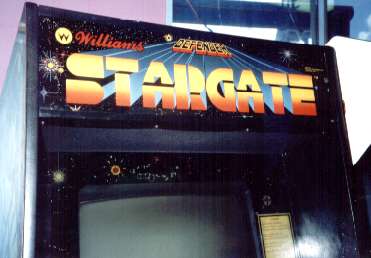 STARGATE - The totally unashamed recycling of Defender. It had everything that made Defender so appealing but the problem was that only those already studying Defender were potential customers and that was hard enough as it was! It probably seemed like an excellent idea in the Williams boardroom of adding quirks to the game which was already taking huge amounts of money in arcades all over the world - with some places housing 3 or 4 Defenders in a row! I hunted high and low for Stargate. As a 16 year-old Defender maniac I wasn't going to let a few hundred miles come between me and this much-talked about version. It had to be played and then conquered - it was as simple as that. Regrettably, my quest went largely unfulfilled and since its 1981 debut, I've only ever played on two - and they were both in the same parlour! The game was in essence Defender. Smarter old enemies, newer enemies, sexier graphics, a 'stargate' for warping and yet another button ("Inviso"), but it was still Defender. That was where the ultimate challenge lay, not this new-fangled spin off only found half way down the country we professed to one another. Even to the great Defenderers, Stargate was bewildering. There was simply so much going on at once that the normal precision manoeuvring was made impossible and unless you were blessed with four thumbs. the new 'inviso' button proved worthless. Williams went understandably overboard on the whole thing buoyed by the massive success of its predecessor. There were new heights in bookkeeping tallies for the operator, testing programs for the engineer and extensive game difficulty permutations with a new buy-in facility which gave you another couple of men for the game for an extra credit. Bonuses were boosted and the game no longer clocked at a million - it was 10,000,000 now. The name up ceremonies were entertainment in their own rights! A good player entered the realms of the "Stargate Immortals" on a 40-strong all time list while a real big score earned the addict the status of "Mortal".....and should you ever become the game's highest ever scorer you had no less than twenty spaces to digitally chalk up your victory message - usually totally obcene. There was also little joy for the egotistical scoreboard hoggers like myself who toiled for months in order to achieve all eight top scores ; 1. 999 975 GUS 2. 999 975 GUS 3. 999 975 GUS 4. 999 975 GUS 5. 999 975 GUS 6. 999 975 GUS 7. 999 975 GUS 8. 999 975 GUS The Williams boffs limited individual entries on Stargate to five a piece with the new 100 place screen of fame (rather unfairly I though) so that only your best five scores were on show but with clever use of full stops and gaps and dashes, players using only two initials could get about 40 up if they so wished. This was also the case on Joust and Robotron as was the ability for the operator to type in a custom message which appeared on the game's attract mode. Stargate and I had what can only be described as a 'one night stand'. We met in a arcade for several hours of bliss and then parted on friendly terms - me going back to my true love, Defender and Stargate returning to relative obscurity as a Defender player's plaything |

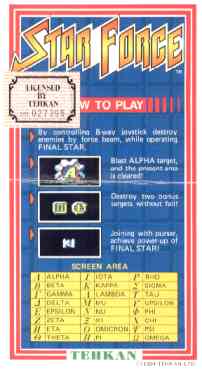 |
| STAR FORCE - One of the best firepower games of the lot. Having completed our apprenticeships on Defender, M.P.S. and I turned our attention to this Tehkan great of 1985. Defender-esque hard work and firepower was required to blow up the aliens and bases to maximise the bonus potential and once again we were hooked. Another factor being that the game didn't come to an end like most of the new releases, we devoted great chunks of our lives to Star Force. We ended up playing it for money we got so good and scoured the country to take the high scores. It got to such a stage that if M.P.S. failed to reach the 2,000,000-point mark he wouldn't even bother putting up his initials! I was good for a couple of million but M.P.S., as he did with Defender, made playing it into an art form. With two of the almost impossible "Cleopatra" bonuses (worth a cool million each!) which required 32 frantic shots in total to uncover and destroy it - all in a matter of about three seconds. he racked up 4,100,000 points one day in nearly two hours of play. The highest score we ever attained on a video game (except the Paperboy fault) was on a Star Force in one of those rickety fairground makeshift arcades. We'd been following this same Defender and Star Force around all summer and after a typically wet August Bank Holiday we arrived at the latest venue to show the locals how it was done. This time though, woe upon woe, SF was out of order and the attract mode of the game was behaving strangely. For the small wager of 20p the 'out of order' sign was discreetly removed and off we went on an amazing game which would never be repeated. Immediately it started dishing out multiple extra ships and volleys of the precious 'Cleo' bonuses in the damp surroundings. After three hours sharing and losing half of our body weights in sweat, the game reached 99,999,900pts and went over to display the score in letters ! |
| CENTIPEDE - Atari's only female programmer of that time, Dona Bailey is credited with this mid-1981 release along with Ed Logg. The Centipede world was one of tiny mushrooms, spiders and naturally, centipedes. Its huge success was derived from appealing to both sexes and like all great games, it provided challenges right through the skill range of players. The better you got, the more you wanted to play. Controlling your 'bug blaster' with a neat little rollerball (much more user-friendly than that huge thing Missile Command sported), you'd fire manically after scorpions and fleas as the main foe of the centipede worked his way down the screen. Thankfully for the likes of me a grasshopper and other creepy crawlies were omitted from the final program, although the grasshopper remained in the self-test mode. I've easily watched more games of Centipede than I've played but after marvelling at many a top player, I still never witnessed the rumoured programme madness after 800,000pts where numbers and letters apparently take over the screen! Centipede put a great deal of new customers into the arcades with its novel scenario and entertaining sounds. There simply wasn't any mistaking a good loud Centipede over the mishmash of everything else in a crowded arcade. A quirky copy soon found its way into the odd chipshop here and there but it was poorly counterfeited and produced that anyone playing it was lucky to see the game out before the screen froze or the whole thing went off. To copy Centipede, or any of the boom games was like covering an Elvis record, but the fact of the matter was that the game makers like Atari and Williams just couldn't keep up with demand. So many people wanted to play that any machine - good or bad - would take lots and lots of credits at that time. Back at Dayvilles The Centipede crown was fiercely contended with the honours of being in the top three swapping almost daily at times. There wouldsometimes be weeks inbetween A.P.S., N.A.S. and B.I.N. visits to the game but when one of them knocked another's score off then it was on for young and old for a few weeks solid. They were all 600,000 pointers - even on the unheard of difficulty level and miserly 20,000 spare man - but were no match for a player who attained over that magic 800,000pts in Chicago in late 1981! After only a few months in the US arcades, he won the National Centipede Tournament and a car and $4,000! The Centipede kings had plenty of tactical ideas like leaving certain mushroom formations and shooting bits here and there - all lost on me as I reckon only a pure genius can score over 22,000 ... ...enter Jim Schneider from California who amassed 22,000,000 one day when had nothing better to do! |
| FROGGER - With American folk song music playing away in the background, Sega's amphibious release made big money and sales. The plight of a frog trying to cross a busy highway and a log-bound river provided a relaxing diversion from the shoot-em-ups and maze running in '81. games were now being made with high score boards - or at least a way in which to digitally carve three initials for the world to envy and although Frogger offered the top five scores of the day, having no "name-up" facility the more competitive players concentrated on other titles. Still a great this one though. Again the copyists were out to cash in on such a moneyspinner and even though Sega were said to have included a free credit bug in the program should it have been counterfeited, "Froggy", "Frog" and "Frogs" all surfaced as clones but without the musical backing. I can't vouch for the accuracy of the free credit story though and believe me, I've tried most things to make that last 10p last. I had to stop playing all my known Frogger's after finding out that all my remaining frogs would be inexplicably massacred after the 8th sheet! |
| BATTLEZONE - What a year 1980 was. Yet another all time great was released by Atari the prolific game makers. With it's Sunnyvale factory working flat out and overflowing with ideas and concepts, they released this X-Y ground breaker in a midi stand up cabinet and a full blown seven footer - complete with mock tank sight. Battlezone was so good in fact, the US Army were rumoured to have commissioned Atari to build a $15,000 version called "MK60" for training purposes! This first person tank game ranks high on my fave list and high in the classic stakes. The intense white line graphics (with green and orange cellophane overlays on the monitor for colour) were perfect, the 3D imagery like nothing seen before and the sound effects were, well something else. The game incorporated conventional tank controls and the levers housed a small LED fire button for thumb use. You were out there on a strange green planet negotiating see-through box-like boulders while dodging enemy tank fire and periodic attacks by evil missiles. It was great - and still is. All this against a backdrop of an active volcano and a huge crescent moon! Because of the nature of Battlezone, most people picked up the idea after only a couple of credits. The problems came when you tried to advance beyond those first few tanks and build a score worthy of your expense. The only way to get the pointage needed to earn a second extra tank (100,000) was to unlock the mysteries of THE SYSTEM!!! Once you had found it - or copied that magic technique, you were in to hours rather than minutes. The way? Well it's hardly important now but it was as simple as the battle idea itself. Whether it was a deliberate ploy by the programmer or a bug I don't know, but being able to manipulate the enemy tanks down the side of your tank, backing up quickly and turning into them, catching them on the turn to destroy them was almost a guarantee of 150,000 pts! This operator's nightmare was a joy to behold as players like MAT became one with the machine. The smoothness of the tanks combined with his jerky but robot-like precision was man and machine in perfect harmony I tells ya! This was a great way to top the high score table but the way to ridiculous scores on Battlezone required 'the knack' in conjunction with timing and millisecond perfection in all of the five or six moves required to eliminate a tank. This is where MAT came into his own. While the others were good for say 300,000, his finely tuned skills with minimal variation in the execution of each move made for mammoth totals. For players like MAT, an ability to stay awake for days on end also helped as the real Battlezoners homed in on the game for scores in excess of 10 million. If I remind you that one million on Battlezone took up to an hour and a half then as an operator you wouldn't be completely out of order if you offered such a player 10 credits to actually stay OFF the game! Of course with multi-million point playing some operators gave the game the boot earlier than would have been normal. Battlezone wasn't exactly free from break downs either. After a good deal of 'body English', over zealous yanking of the controls and general abuse, the game would start playing up with monitor problems and control failures. Most operators neglected the instructions from Atari to lubricate the controls and this lack of maintenance was partly to blame Battlezone's limited lifespan in some venues. The cabinets weren't a viable proposition for conversions either, having a small black and white X-Y monitor and custom controls usually doomed the unreliable games to the hammer. The great 3D graphics combined with audio marvels such as the low engine rumble and spooky saucer, really put you out there in the middle of nowhere with only a thumb trigger and turret gun to defend yourself. Thorough as ever, Atari made the game available with extensive self tests and four languages settings! What also was included with a new Battlezone was quite a few bugs, courtesy of typical computer schizophrenia which infrequently awarded the unsuspecting player 3,5,7, or 9 million-odd points for hitting the first tank! The give-away was that the score contained some letters and only one tank followed your registration as a high scorer - rather than one for each hundred thousand. Thanks to this problem most seasoned Battlezoners have been the recipient of such a bounty. I've got 9,922,000 to my name and I can tell you that coming so close to 10 big ones almost made me sick. After an hour or so with the free nine mill, I looked up at my score and cracked! Ex-'Zoners across the world will never forget the way each tank exploded in fragments, the eerie way the saucers hovered about and above all, the thrill of your very first 100,000pts fanfare! |
| TEMPEST
- The most radical of arcade games. Along with the likes of
Asteroids, Defender
and Space Invaders, Tempest
has to be one of the greatest games to ever grace the arcade, chip shop,
cafe or pub. If Defender was the most
challenging game of all time then Tempest
must wear the crown of 'most spectacular' for that era. Such sharp and
vivid colours making fantastic shapes and effects were way ahead of
their time and it's only now that game graphics are again so
breathtaking. Tempest was undoubtedly
Atari's finest hour but it slipped into cult status rather than keeping
up with the big games of the early 80's. This was directly due to it's
own uniqueness, hardware problems and the vidiots fave
discovery.....program faults which couldn't have possibly been
anticipated by any rigorous amount of testing. As is still the case, a
programmer or manufacturer just can't afford to site test games for
months on end. Whatsmore, some of the best faults have been only
uncovered after some years of extensive playing by the die-hards. The
demand for new games and concepts in these boom years far outstripped
supply on most occasions, so time was of the essence in releasing many
of the now famous titles. Even so, Atari furbished every new
Tempest with a wad of manuals to cover
every conceivable operator problem or breakdown in their usual excellent
customer service role. Sadly they had not. The game was dogged by
monitor problems and worst of all, software bugs the likes of which will
never be seen again. This, along with poor takings from the majority of
sites due to neglect of the superb rotary controller led to the
consequent obscurity of Tempest. Only the
best (and smartest) operators took time to carry out the inevitable
lube-jobs such great designs such as Tempest,
Missile Command and Battle
Zone required with their daily rigorous workouts. Without these
1,000 credit services, some games soon became unplayable. Some games
could go a week before the operator realised the joystick had fell off
or a button had stopped working. They foolishly only were interested in
takings rather than maintenance. The utter frustration of eventually
finding a Tempest only to realise, after
you and your money have parted company, that the knob or one of the
buttons didn't work! AAARGH! Coming 18 months after Asteroids, Atari
boasted their first colour X-Y game in Tempest and so justifiably proud
were its makers that they included a demo mode and even a freeze-frame
mode just for fun. Intended only for promotional purposes, us gamesters
soon found ourselves amongst the thick of it. An operators could stop
the action on any of the 96 play fields to admire the dazzling effects
and the game options were better than ever - different languages, bonus
settings galore and the by now statutory bonus coin option where a
player parting with say, three credits, got another game for free! Even
the start level was linked to the high score and it had a "TILT"
alarm for those more enthusiastic players. Wow what a game this was. As
any Tempester knows, game play revolved around the manipulation of a
claw-like yellow thing which sidled around the rim of a strange shaped
tube which was suspended in space (where else?). Flippers, Tankers,
Pulsars and Fuseballs crept up the playfield toward your claw whose only
sure-fire form of defence was the Superzapper. Firing down that deep
tube in the region of the weird and wonderful alien forms as they made
their way up to manically circle the rim, was more difficult than
anything else in my life as fifteen year-old. Whenever I played there
always seemed to be a convenient gap in my frantic firing which allowed
the aliens to explode (in great fashion) my "gizmo" claw type
thing. Tempest was not just a brilliant
game though. It also served as a major talking point between arcaders
and was great to watch, if you didn't have the knack....like me! For
myself and M.P.S., it provided endless hours of pontification and debate
- and still does! Of its 96 levels, there were 16 differing shapes/tubes
and 6 groups of colours as expert players like M.P.S. entered the realms
of Tempesting immortality and stardom with scores above and beyond
700,000 for 10p! Actually I say 'six' colours but that's not strictly
true. Levels 64 - 80 were in fact invisible! As if all this splendid
entertainment wasn't enough, Tempest had a
dual personality. The most unusual, baffling and eye-popping program
faults to ever manifest themselves on a video game monitor were
initiated by a tally of bizarre coincidences some Tempest lunatic
stumbled across. That's one theory anyway. Whether it did
actually happen accidentally is a moot point, but unless there was some
kind of program sabotage out there in Sunnyvale, USA, by some really
nasty and disgruntled individual, then this little lot will always rank
as the most catastrophic set of bugs of all time! Who found the faults
or who leaked them has never been of interest but the video gaming
international grapevine saw the bugs being whispered about in the
darkest corners of arcades and even being published in some of the
monthly magazines! So with crib sheet to hand, the tricks were available
to most serious arcade-goers but actually executing them was another
matter. By twice completing the RED 9th level yielding 188,000 pts in
bonus from the start or any harder level, killing off one or more
remaining lives after obtaining a score ending in the following two
digits, extraordinary things would happen only after two full
attract-mode messages of "TEMPEST"
were displayed after "GAME OVER"! I'm sorry, but it still all
seems a little contrived to me. Anyhow, ensuring your score ended up
like so, enabled the following 'bugs'............ ???,?00 - froze the screen images, sounded the 'tilt' alarm and locked up the game. ???,?05 - allowed play on the attract-mode and initiated the following..... ???,?01 - revealed the bookkeeping totals. ???,?06 - issued 40 credits. ???,?11 - issued 40 credits. ???,?12 - issued 40 credits. ???,?16 - issued 40 credits. ???,?17 - issued 40 credits. ???,?18 - issued 40 credits. ???,?14 - credit sound only. ???,?15 - credit sound only. ???,?41 - swapped digits to 14. ???,?42 - rapid increase in score, sometimes taking it over the magic 999,999 pts and displaying letters instead of numbers! ???,?46 - allows the next game to start on level 81 (898,000 pt bonus) ???,?50 - claw moves independently of the controls. ???,?51- claw moves independently of the controls. ???,?60 - aliens and claw detach themselves from playfield, sliding down and off the screen! ???,?66 - the same, but off the right of the screen. ???,?67 - the same, but in all directions erratically. ???,?69 - same, but up and off the top of screen. ???,?70 - same, but off lefthand side of screen and out of sight .....and finally, the dream of all players.... ???,?48 - which dished out 255 extra lives! As you can see, arcade owners weren't too impressed on finding players sending the machine into convulsions and being handed 40 credits (£8.00 if it was on 20p play) for their trouble. This then was the final nail in the Tempest coffin. Tempest, possibly the greatest game of all time and the 'Buddy Holly' of the video game scene. What went on inside Dave Theurer's mind the day he invented Tempest is a well discussed topic. had he been drinking or what had he taken? Is he deranged? The only thing for certain is that it was a miracle! |
| SCRAMBLE
Unkindly labelled as a "poor man's Defender"
by some, Scramble was a great game in its
own right. This comparison came chiefly through the game's use of a
horizontally scrolling space format and the copy of the
Defender ship on the counterfeit version.
Your survival was in the hands of an 8-way joystick and your ability to
precisely drop bombs and fire volleys of bullets in one of five
scenarios. Early issues of Scramble proved to be too fuel thirsty so
with a slight alteration by the Stern boffs, the game became legendary
amongst precision enthusiasts. Hitting those fuel dumps was the key to
success and as the landscape passed by, waiting for no-one, rockets
launched themselves at your ship and UFO's weaved a path of destruction
if your fire power wasn't up to it. Then there were the comets. At the
speed of light you'd need to dodge madly as they careered at your ship
and if you made it past those there were close range rockets perched on
top of skyscrapers to see you off. My goal for months was to clear the
buildings and conquer the maze at the end to reach the POD only to find
the whole thing start over again but even harder! Getting to that pod
regularly required and uncanny and unnatural manipulation of the
sometimes dodgy joystick. You just had to be man and machine in perfect
harmony. On the 26th July 1984, KPH did just that on Blackpool's South
Pier arcade. We'd been playing Defender all day and decided to have a
doubles game on Scramble for a short break. It was a 4 ship start, 20p
credit and had no sound. It was also a good job I had my trusty notebook
with me... -------SCORE ------------------Killed By------- 1st man = 204,000 (204,000 pts) - Comet 2nd man = 240,000 (444,000 pts) - Comet 3rd man = 240,000 (684,000 pts) - Comet 4th man = 280,000 (964,000 pts) End POD ! Last man = 8,000 (972,000 pts) U.F.O. Total Waves / Flags = 40 (16 shown) Ave. per card = 24,305 Total Game Time = 2hrs 15 mins Total Game pts. = 972,250 (K.P.H)+26,750 (GUS) = 999,000 !!!!! |
| PACMAN - Like Space Invaders, there's not many people who don't know who this character is. The little yellow muncher was another craze wave to sweep the world and instantly appealed to young, old, male and female alike. Namco's Pacman, licensed to Midway in 1980, attracted millions of new customers to the arcades and parlours globally. There are some ridiculous stats about the game like how it earned $60 billion in its first year of production and how Well over 100,000 units were sold eventually - with at least the same number being illegally copied. I'm not about to insult you by attempting to explain the Pacman fundamentals because after all, unless you've been living under a rock for the last twenty years, you'll be fully aware of this legendary format. The word "paku" is Japanese for 'eat quickly' and if you failed to do so it was curtains for that hard earned credit. Puckman was the preferred name for release ('PUK' being similar to the sound you make while eating quickly) but when it realised that in English the word could be easily defaced to 'Fuckman', Pacman became the title. Slight changes in scenery were provided by the forgers like extra tunnels or differing names for the ghosts and so on but the magnificent Midway cabinet was the one to seek out. The little interludes between screens were fantastic at first....even though later served only as a distraction to your concentration as you focused on the highscore. The screens were denoted by the bonus fruits available which in turn indicated the moods of the ghosts and as their value grew in stature by completion of each card, so did the temptation of risking one of your three or four lives to devour it! With so many versions of Pacman in circulation, confusion reigned amongst players about scores, fruits, set plans and whether or not there was really a modification kit to toughen up the program as everyone got better. Buffs started to appear and game patterns were formed for invincibility and maximising your score. Some even sold! These game-beating patterns seemed great in theory but having the memory and dexterity to perform them was out of most people's league. With books like Ken Uston's "Mastering Pacman" and patterns being printed in magazines here and there, the elite players did manage totals well in excess of most players wildest dreams. Of all the variations of the game, good, bad, legal or otherwise, the most ridiculous one I've played had Pacman tearing around the maze at breakneck speed enabling even my feeble efforts to make the high score spot which strangely didn't allow the player to enter any initials - a definite negative as it was almost commonplace by now. The odd fault like the screen coming on back to front or the game forgetting to put a new maze up paled into insignificance compared to Pacman's most talked about glitch. The snag was that this mega-fault could only be achieved by the most brilliant Pacmanner after hours of mind-bending dot gobbling. It was that after the 255th screen the game gave up and reverted to displaying half of the maze in machine code. This phenomena was dubbed the 'split screen' by the experts and should have spelled the end for the game - already 3 or 4 million points old! - but they were still able to play on by all accounts! |
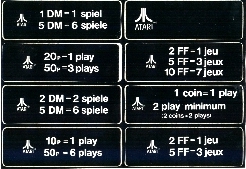 |
| ASTEROIDS - By April 1980 Atari's Asteroids had taken over from the mighty Space Invaders as the highest earning video game in the world. At only five months old, the game spoke volumes for engineers Lyle Rains and Ed Logg. Rains had come up with the simple but compelling idea of blasting big rocks into smaller ones - and finally vaporising them completely! When they added a Lunar Lander-style ship, a couple of flying saucers and a hyperspace feature from Space War, Atari's best ever selling coin-op went into production. Sounds simple enough put like that but in reality Asteroids was - and is - one of greatest games of all time. It was much more than a few bits from here and there. The X-Y graphics were perfect for the job and the way your ship floated around in no gravity was at first very strange to handle - unless you were one of the very few experts of Space War. The audio features were a marvel in their own right even though I can't help thinking of the similarity between Space Invaders' monotonous background "THUD, THUD, THUD, THUD" and Asteroids'. As the tension mounted so did the speed of the "thuds" so increasing the player's fear even more. Great programming when you bear in mind the archaic electronics available in those days. Remarkably, around 90% of the final 70,000 games were employed on US soil and the new theme of boulder crunching was an immediate and runaway success story - as remains so today. With your ship suspended in space, the only way to avoid the asteroid onslaught was to fire, thrust, spin and hyperspace - sometimes all at the same time! Whether you were a 'lurker' or a 'spinner' or a 'thruster', there were no certain ways of escape from those mean little saucers either. Your new-found career of boulder-bashing was a painful and short one at the outset. Actually getting on the machine could be a problem as well - a queue of five deep or a pile of awaiting credits being the worse scenario for someone itching to be transported to an asteroid belt in outer space. Gladly, even the most inept player was able to register a three-lettered name if they got to the machine early enough as Asteroids usually logged ALL scores of the day on its top ten. My first games were pitifully low in pointage but I felt a whole lot better after witnessing nil by some poor and unfortunate soul who was having problems distinguishing between the hyperspace and fire button! - The video game player's worst nightmare.....10p for 0pts. Grossing around $800,000,000 US in its best year, Asteroids gave Atari a much needed boost and with their ingenuity, the game featured subtle firsts and new programme options like being able to run in four languages and the choice for operators to alter the required score to get your name up - somewhat of a curiosity as the extra ship value could not be altered from 10,000 pts! Later on as the specialists emerged, Atari made available a modification kit to fit the game which promptly halved everyone's scores and doubled the takings as I remember. With such prolific earning potential, this celebrated game was copied tirelessly by the bad guys. Even though the original had a few flaws, the duplicates such the as totally inappropriately nam ed 'Meteor' and 'Planetoids' were extremely duff. Of the millions of global credits which slid down the coin doors of these cheap counterfeits, some gave a little more than expected at times. Quite apart from the vandalisation of the famous little red LED start buttons and wear and tear experienced by the workhorse models, I've also had to but up with silly coloured overlays (a practice employed in those days to eek out a few more credits from a flagging black and white game), a thrust HANDLE which rendered a proper game impossible - unless you possessed a third arm to reach the fire button! - and a game which forgot to issue extra ships! Blinding screen brightness exposing the off-putting, if not interesting, flyback lines of the X-Y monitor could easily be equalled for a bad experience by trying to engage in rock smashing while the small saucer sound effect permanently blasted out all game. Added to all these enigmas were the screen that occasionally filled with computer code, wobbly watery monitors, games which flashed on and off constantly and one where all the saucers had only half value! The mysterious 'magic pop' was a major talking point in 1980 between Asteroiders. It occurred when a large boulder was hit and instead of splitting into two smaller ones, it disappeared! Making encores on Space Duel and Asteroids DeLuxe, this magical pop was caused by having too many characters on the screen at any one time. The poor old processors in those days couldn't handle more than 35 items at any stage so something had to go! To the untrained ear it was merely a pop but to an asteroid wizard it was a spectacular loss of points........but worth it. On the older games, before a hasty programme change by Atari, the asteroids would pass through a players ship without harming it if positioned in the lowermost available part of the bottom left corner of the screen. Using this technique early exponents would rack up millions of points even though the on-screen maximum was a pathetic 99,990. It wasn't uncommon to see players with a row of extra ships awaiting use after a couple of hours of 'safe-spot' shooting. Having a threshold of 60 spare men, the programme was soon forced to display the ships across the top of the screen and off the end and then to start a new row underneath the score! What a sight! After all, that amount of extras represented over 600,000pts worth of shooting. This fault, the so-called 'wraparound' screen shots and NOT using the hyperspace (which destroyed you on re-entry more often than not) spawned multi-million point meteor munchers everywhere with the top of the heap being the amazing 30,000,000pts by Kenny Hernandez in New York 1983 which took up 52 hours of his life! In its twilight years the game which Clint Eastwood had in his lounge, bowed out of service when the cabinets were usually stripped for conversion or the more sentimental of operators lowered a game to 5p or even 2p to keep it alive. As I recall, Asteroids was the only game to actually have a smell. No, really it's true. Whether it was the paint used or the combination of chipboard and the steel of the large control panel I don't know, but its musty smell is still remembered fondly by all of us who had their first game way back in the summer of '79. I mentioned earlier the sequel of this wondrous game so let's not forget the titanic struggles ex-Asteroiders had with the evil Asteroids DeLuxe. Hot on the heels of its big brother's success, DeLuxe was recalled almost immediately to iron out a few embarrassing oversights like bad screen visibility and to slow the game up in order to attract the non-miracle workers. Hiccups aside, the addition of upgraded graphics and the replacement of the hyperspace button for something more useful - a shield - made for a very similar but exciting game. DeLuxe's most significant change lay within the rocks themselves though. This time the asteroids spun towards your ship rather than just floated - oh the fear of seeing that for the first time! Obviously intent on committing hour-long games to history, Atari threw in another means of destruction for the player, namely the 'killer satellite' which teamed up with the saucers to hurry your demise. Towards the end of a card this evil piece of work would heat-seek your ship after being struck, and only if you were lucky would you be able to waste most of your shield on it rather than being immediately doomed. DeLuxe pandered to the player who yearned to have his name in lights. The top three scores remained even after the game was switched off - somewhat of a talking point back then. This was of little consolation though for the imposure of a maximum ten awaiting spare ships at any one time and a pretty nifty speed up after 60,000pts. My only memorable achievement on DeLuxe was during my college days where I held the top three scores for nearly three years! Sounds good but I only wish it was the greatness of the scores which kept me there rather than the game's dismal takings! |
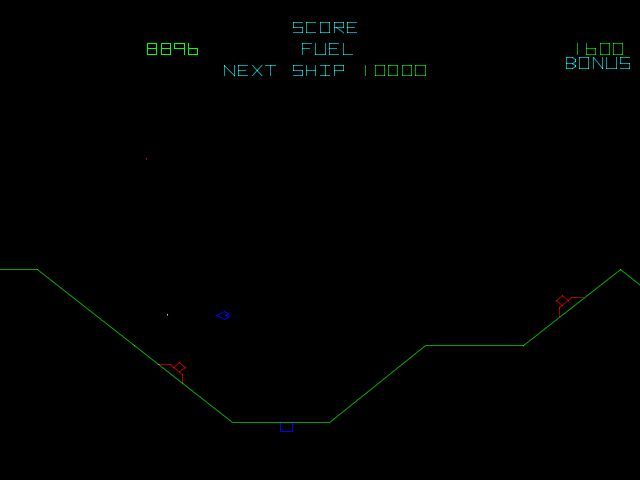 |
| GRAVITAR - extraordinarily difficult offering from Atari using the Quadrascan X-Y monitor. It was basically a nice looking cross between Asteroids ans Space Wars but it was too tricky to catch on as well as others |
| STAR WARS - Ace effects with Atari's awesome X-Y display. Took speech and effects from the film superbly while remaining truly addictive and fun to play. Reliability of the monitors always dogged these leading edge games and they spent a fair amount of time out of service. |
| SPACE DUEL - Why this game never caught on in a big way is a mystery to me. Maybe because they were very scarce - in the UK at least. I was in arcades almost every day in the early 80's and still only ever found two. Perhaps us arcadies had had our fill with Asteroids and the DeLuxe but on closer inspection, Space Duel was only a distant cousin of the classic. Atari employed their famed colour X-Y monitor and the graphics, sound effects and gameplay were predictably superb. Dual play was the theme here and ex-rock bashers could team up or go solo against a whole host of coloured 3D wonderful spinning shapes. They rained toward you as the four-speaker system bombarded your senses in this richer version of an old theme (even the magic 'pop' remained when the screen became overloaded). Atari made sure that Space Duel would never fall prey to the multi-million all day players as they, and most other makers, imposed limits on extra men and so on. The ever-increasing computer power also meant that a game could speed up ridiculously after a while and thus weed out us profit wasters for good. |
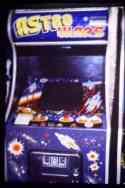 |
| ASTRO WARS - |
 |
| POLE POSITION - |
 |
| Boot Hill - |
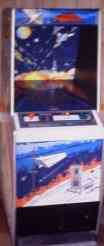 |
| ASTRO FIGHTER - |
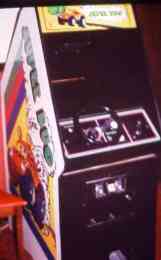 |
| SUPER BUG - Highly addictive non-CPU game |
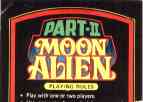
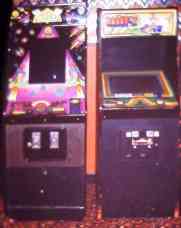 |
| MOON CRESTA (seen here with a New Rally-X) - Aroundabout the same time as King Kong roamed our arcades, the Japanese firm 'Nihonbussan' released a game under a company synonym "Nichibutsu". Thankfully the game title was easier to pronounce than the maker's name and Moon Cresta' was born. An interesting space base game which allowed all three of your ships to congeal as one awesome 5-bullet shooter - if the tricky art of docking the ships onto each other was mastered. More often than not I was left with the puny first ship to ward off the erratic cascades of alien forms. This was what made Moon Cresta so great.....the all important greed factor! Only one in ten of my credits realised a full five bullet shooter and that was more by luck than judgement. I'd say to myself on the seventh consecutive credit "this one's going to be different" or "just get the docking right and I'll be on for an hour". I never was. A minute and half was more like it. I never saw a score on Moon Cresta above 150,000pts and that was a rare sight indeed. The game always came out on top and this may be because legend has it that the first batch of games proved to be too easy and in a certain graceful panic, the makers hastily flew the game programmer to the US to make them all more difficult! |
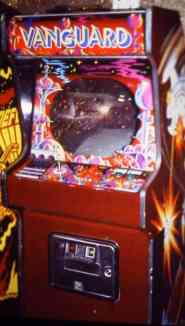 |
| VANGUARD - |
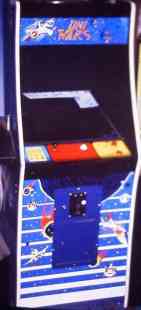 |
| UNI WARS - |
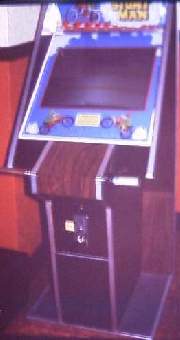 |
| STUNT MAN - |
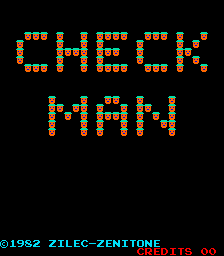 |
| CHECKMAN - |
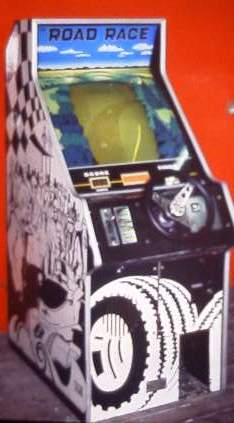 |
| ROAD RACE - |
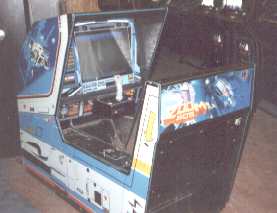 |
| BUCK ROGERS AND THE PLANET OF ZOOM - |
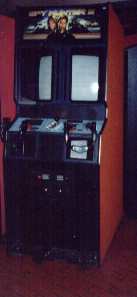 |
| SPY HUNTER - |
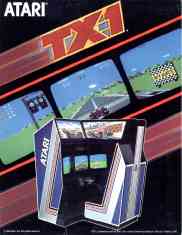 |
| TX-1 - |
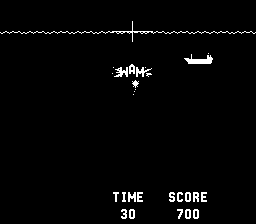 |
| SEAWOLF - After 1972's Pong, Seawolf was the biggest selling arcade game with figures topping the 10,000 mark following its 1976 release by Midway. If you recall, it was a boat versus torpedo game with a black and white display and cast metal periscope - freezing cold in the winter! Players worked against a timer and the mere presence of it was unnerving enough to ensure a short game. High scores on Seawolf were irrelevant really with the inclusion of the quite extraordinary 'high score reset button' on the cabinet but for the mogul of Seawolf, the very thing everyone else hated he loved. The dreaded timer actually served as an invaluable aid to predicting the arrival of the smallest and most point-laden boat worth 700 pts! With the limited capability of software in the mid-70's, the player was required to use his imagination sometimes more than his skill. Should you hit a mine on Seawolf, for instance, then the plot had us imagining our sound effects with the appearance of "WAM !" and "ZAP !" on the screen in true comic-book style.. |
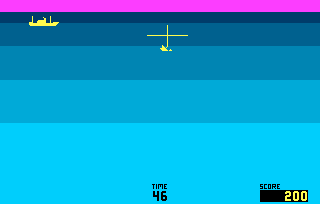 |
| Seawolf 2, released in 1978 |
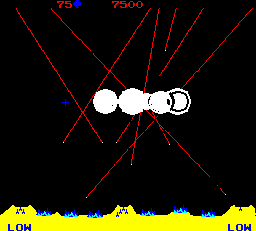 |
| MISSILE COMMAND - The threat of WWIII between the US & USSR proved the catalyst for Atari's 1980 release Missile Command. Known as "ARMAGEDDON" to all that worked on it back at the factory, Missile Command was another masterpiece in binary from Dave Theurer, Atari's chief programmer at that time. On the original concept he is said to have used the Californian coastline and six of its major cities to battle against the Reds using inter-continental-ballistic-missiles. Players had the unenviable task of protecting the cities with a barrage of bullets using a remarkably precise roller-ball and its accompanying three firing buttons. Working out on that enormous track-ball was like a war in itself at times and I can personally account many a blister and splintered fingernail to it. As I launched volleys of anti-ICBM's from all three bases, there always seemed to be a tiny gap where the clever little smart bomb would squeeze through and destroy one of my poor cities. Failing that, over would come the bomber plane or satellite just at the last second, dropping furiously as I discover that all my bases had been exhausted! Nation-savers soon started hitting the 400,000 and 500,000 pt mark and within a year the word in the arcade was that at 800,000 pts the game gave out an amazing bonus of 256 extra cities! True or not, like the reputed Centipede quirk, Missile Command never really suffered mass expert overload like some of the other classics. It wasn't unheard of getting 999,990 on a really generously set machine, but it was pretty rare and a achieved by few of the gamesters I knew. That said, a gruelling 69,000,000 pts by Victor Ali in the States made even seven figure scores look pathetic! Highly addictive and sometimes strenuous, the Missile Command everyone got to know was a toned down version that retained little trace of such a serious conflict as that pondered by the nuclear shelter-buying public. The way the game finished was the one great feature that did remain though. It made little difference to my game whether the numerous settings were on easy or hard with generous or miserly bonus cities - it only served to prolong the impending doom of civilisation emblazoned eerily as "THE END" in huge lettering across the screen following the big red and white atomic explosion. |
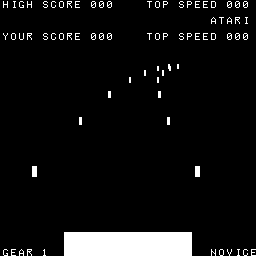 |
| NIGHT DRIVER - The first mass produced (2000 units) sit-down video game was Atari's Night Driver in 1977. The game was released in '76 as a conventional upright with those classical graphics and little white bars passing the stationary car giving the illusion of a fast moving and winding track - what a great and enduring piece of programming. This superb black and white game was supported by a lifelike fourspeed gearshift, pedal and steering wheel. It's a concept that was emulated time and time again - especially for the home games. If you were like me, then the car spent most of its time in the fence awaiting the tow truck as the track seemed to weave and curve far too erratically for my skill level. Fantastic speeds of 200 mph, 300 and even 500mph were displayed by the best drivers, but with every post passed worth only one point, scores were minuscule compared to the unnatural skill required to achieve them! Your credit, as it clunked its way down the all metal coin slot and holster, bought you a game lasting between 50 and 125 seconds (depending on the generosity of the operator) and hence qualifies Night Driver along with Seawolf as one of the earliest 'limited time' video games so popular in the mid-80's. |
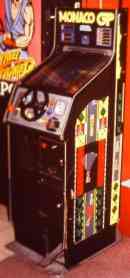 |
| MONACO GP - This Gremlin/Sega effort of 1980 was unquestionably the best driving video game to date. Available as an upright or larger snazzy sit-down model, Monaco GP sparked the transition of driving games to 'driving simulators'. Although not a first-person game in the simulator sense, it did boast a padded seat, a hi-lo gearshifter, great audio and even a few mock dials. The car sped through day and night scenarios - headlights and all - and obstacles like puddles and ice and ambulances now began to look real for the first time in video gaming history. With all the programme invested in game play, the score was displayed by L.E.D. readout off screen on the side of the cabinet but it didn't matter! The sequel in late 1981 was called "Turbo". Another class act which added to the format with bridges, streets, tunnels and a down hill slope of all things to wow video-racers. So lifelike in fact, there was even a winner's wreath at the end of it all. The smarter players soon found out that by swinging the car hard to the left at the beginning of the race proper lapped the field instantly! |
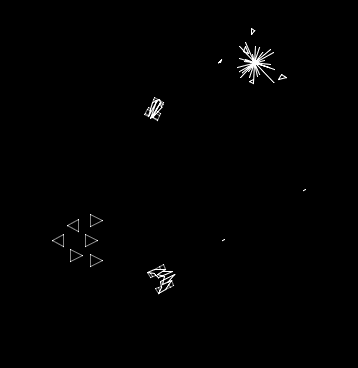 |
| RIP OFF - This two-player gem with 'vectorbeam' graphics was far from what the title suggested - unlike some of the dodgy copies of games we endured during this period of gaming. Rip Off was one of the finest team-work games ever produced. It was released on us in 1980 by Cinematronics and the gist of it all was to prevent your supply of triangular fuel containers from being kidnapped from centrescreen, as you and your pal laboured to fend off the attackers. Those enemy ships were really hell-bent in robbing that precious fuel from you and when you could fend them off no longer, it was all over. After suffering the humiliation of a hijacked fuel supply, the final scores seemed academic compared to whose fault it was letting the last dumpster of fuel go. As the game progressed so in turn did the much used background 'humm' working itself - and you - into some kind of frenzy. Ten minutes of that and M.P.S. and I would come off the game totally square-eyed, covered in sweat, shaking like leaves and twitching involuntary! |
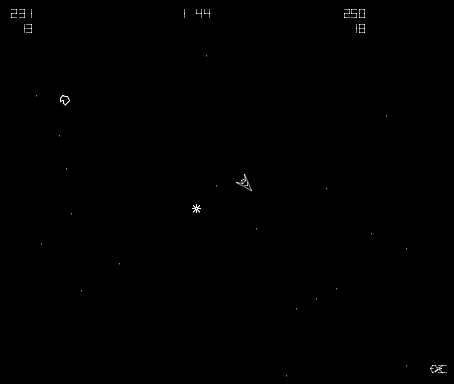 |
| SPACE WAR - The first ever arcade release to feature 'space' as a winning formula was indeed, Space War. Late '77 saw the unveiling of what was the first 'vectorbeam' video game by Cinematronics and thanks to its success, we were treated to such classic X-Y games as Tailgunner, Rip Off, Star Castle and Armor Attack in its wake. The game looked awesome to me as an 11 year-old so I tended to play safe with Gunfight or Superbug. Anyway you needed a willing partner to play it with and in those 'pre-Space Invader days', budding addicts were very thin on the ground. Faced with no less than FIVE buttons each to control your ship, the participants fled around the deep black of space trying to work out what the 'HYP' button was for and dying a miserable and cheap death. The centre console housed a further TEN buttons for game selection and then Space Wars pitted you against each other in a one-to-one dogfight rendering your ship less effective with each hit. With a black hole thrown in for good measure, the magnetic pull of an invisible sun, negative gravity and a 'bounce-back' option for the ship, this was the most frustrating game ever to grace the silver screen. Cinematronics included the innovative 'buy-in' option on Space War - another first - so by adding more credits, the pair of you could battle it out for longer....up to an incredible three or four hours if you were rich enough! With that complete keyboard for a bit of primitive programming and setting up, the theory of gravity and even more buttons was all too much for me. Little did I realise that the huge cabinet I stood open-mouthed at then would become a piece of arcade history. |
| GORF - With taunts like "TOO BAD SPACE CADET" as your credit finished, "TOO BAD" when your ship was obliterated into the famous firework show, "SURVIVAL IS IMPOSSIBLE" and "BITE THE DUST SPACE CAPTAIN" it was small wonder that tempers flared when Gorf was in action. The game with this very electronic voice mocking you constantly made even the most worshipped arcade patron feel inadequate, unskilled and downright depressed. Gorf was five games in one really and one of the earliest 'talkies'. It also sported a great trigger/handle, extremely ergonomic as I remember, and as you grasped it for the first time in March 1981, you were thrust against some old (but wiser) enemies along with some newer ones. There were recycled Space Invaders and Galaxians out there on screen and your man was able to move up and across on Gorf but in all honesty it was unremarkable. It did have those great features but lacked the gameplay its competitors had. For another credit the player could boost his men from three to five for the start of the onslaught and at the end of it all this huge reel of seemingly endless scores and names would scroll on and on for the fame-seekers but for all these gimmicks, Gorf was ordinary AND it made you feel bad! |
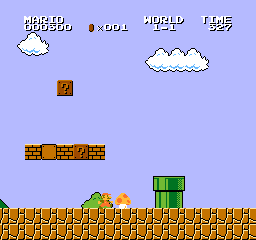 |
| SUPER
MARIO BROS. Nintendo debuted Mario in Donkey
Kong and had a hit with "Mario Bros"
so they revamped the idea and made what has become the most lucrative
and well-known bloke to jump around any video or telly screen since. One
of the first adventure type games with hidden bonuses and vines to climb
up, it really gets you thinking and coming back for more...years after.
Here's the poem Mario the plumber / carpenter or his brother Luigi
(player 2) were awarded on completion of all 32 regions of play (over
about 2 hours) on the original arcade version in 1984 : Peace is paved With kingdom saved Hurrah for Mario, our only hero. This ends your trip Of a long friendship! |
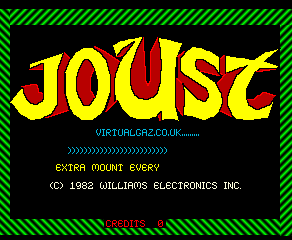 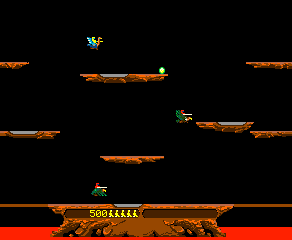 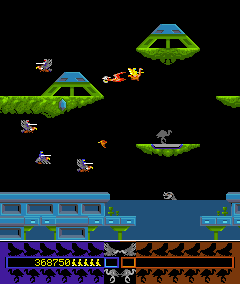 |
| JOUST Williams' first dual-play game entered arcades in October 1982 and pitted you against each other, if you had a nasty streak, or against a tirade of jousters also seated on ostriches! Each player had the comically name 'flap' button at their disposal to avert certain death by being pulled into molten goo by the 'lava troll', stabbed by a jouster or obliterated by a pterodactyl! It was great entertainment albeit a little 'samey' all the way through and the audio combined superbly with the latest graphical wonders from the Williams camp. This game was a bit of a gamble for Williams with its strange scenario and lack of any fire power button but it did fairly well in the US although not so much in Europe. The game was sadly another rare sight in the UK - as was the bug on the earlier games which allowed people in the know to position themselves in such a way that they jousted the 'unbeatable' pterodactyl for 1,000 pts a time while the last enemy was stuck in the lava. It was best in 1 player mode and grossed massive scores of 100,000,000 pts and hundreds of spare lives with it! |
| DRAGON'S LAIR SCREENSHOTS COMING SOON ! |
| DRAGON'S LAIR "Dragon's Lair, the fantasy adventure where you become a valiant knight in a quest to rescue the fair princess from the clutches of an evil dragon. You control the actions of a daring adventurer fighting his way through the castle of a dark wizard enchanted with treacherous monsters and obstacles. In the mysterious cavern below the castle your odyssey continues against the awesome forces that oppose your efforts to reach the DRAGON'S LAIR! Lead on adventurer, your quest awaits....". That was the way in which the first worldwide laser-disc video game announced itself perpetually back in 1984. Sega's Astron Belt was technically the first LD game in mid '83 but was initially released in Japan only while Bally/Midway fine tuned the bugs. By the time BM had finished the game for the rest of the world, Dragon's Lair (Cinematronics release through Atari) was already in the arcades. With its cartoon graphics and incredible sound effects, Dirk Daring proved an instant but brief success. The game could be set to end after the first round or go on indefinitely but poor reliability of this new technology, repetitious nature of gameplay and the novelty factor soon had the game in the video knacker's yard. The disc would slip, stick and sometimes crash the game completely. The rough treatment they got made it worse and some operators offered a dozen spare discs to anyone willing to buy his machine after six months or so. Most releases weren't meant to go much longer in any case. Games such as Dragon's Lair and another great Atari release, Gauntlet had huge takings initially and then faded fast - exactly what they were meant to do! Game manufacturers weren't in it for us idiots who wanted to play all day for 20p or beat a program by exposing faults, they were there to make money and money for their operating customers. Few people were disturbed by its quick demise along with next offering of Space Ace. The sequel Dragon's Lair 2 was shelved until the system could be made more reliable - which never happened. This LD games severely lacked the gameplay and addictive nature of its rivals and required so little skill mastery that it was merely an exercise in memorising what to do in each scene. Maybe this is reflected in the reputed world hi-score of 348,000,000 pts in 95 hours!! |
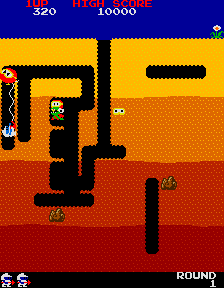 |
| DIG DUG Great game. An underground world of digging up rocks and exploding monsters with a handy foot pump! Atari's Dig Dug had a big following in the arcades I frequented but still fell prey to all-day playing by boffs who miraculously worked out invincible patterns to a seemingly random game. Another one of those hard-to-execute and pointless tricks were spoke about by the same boffs: By positioning Dig Dug under a falling rock and at the same time blowing him up caused the game to remain on that card until you killed yourself under another rock. Because it only yielded a never-ending game where the score couldn't increase, it was more a fault to be avoided than a trick to be mastered. What was the point of playing all day on an empty screen unless you wanted to get back at the arcade owner for throwing you off your high score game at closing time? There were much better ways than that - like chewing gum in a coin slot or destroying the start button. But try as I might, decent scores eluded me on Dig Dug for year upon year even with the enlisting of APS (2,000,000+ pts) as my coach. |
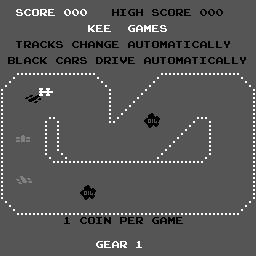
|
| SPRINT The star driving game of '76. Kee Games and Atari collaborated to produce this thriller boasting two steering wheels and gearsticks and included a track-choosing option as well! Back in those days of 'proper summers' and bell-bottomed trousers, vidkids played on black and white games with vast steel consoles where the black paint had worn away to expose the bare and cold metal. Levers were heavy and well made out of solid materials like cast iron and toughened plastic while getting anything more than a 'beep' out of a speaker was unthinkable. Entering your name was pure fantasy and to say the games had 'no frills' is still an understatement of monolithic proportions. On Sprint, 10 pts would be awarded for negotiating your little white car around the flat track as unscathed as possible so as you can gather, we're talking prehistoric here if you've ever had a credit in Sega Rally! Sprint, like games of that era, was played for a laugh rather than competition and let's face it...you had to laugh as your impossible to control 'car' zig-zagged its way across the track! |
 |
| PISCES A hybrid of all the popular previous releases. There was a bit of rock dodging, the odd warp and birds flying around with one wing but all in all just another base-game. Twelfth sign of the zodiac maybe, but the UK attract mode displayed the maker's name "SUBELECTRO" ten times bigger than the game title itself! |
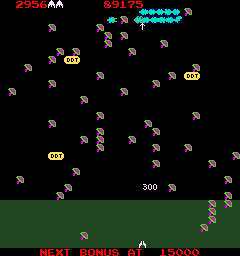 |
| MILLIPEDE The follow-up to the insect invaders of Centipede was, not surprisingly, Millipede. One look at the long list of assailants was enough to put this would-be exterminator off: dragonfly, bee, earwig, mosquito etc. and it was a futile effort unless you'd done your Centipede apprenticeship. |
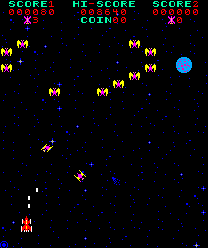 |
| PHOENIX To the tune of electronic Beethoven, your Phoenix or Falcon (UK bootleg) space shooter frantically shot at eggs and birds culminating in a showdown with the awesome mothership in the fifth part of the wave. Easy to play and universally popular, Phoenix still has a stronghold on continental bars and cafes after all these years! Illegal copies were widespread and like all the great games on these pages, it had a hidden program nuance: By shooting three small purple birds for 200 pts each (as they flew back up to the top of the screen) in quick succession on the second sheet of the third wave, the computer was fooled into awarding 204,200 pts! Using the fickle shield at the right moment was imperative but even if it all worked out, 50% of the time the game crashed and had to be unplugged! |
| DEATH RACE screenshots coming soon ! |
| DEATH
RACE The most controversial video game ever released was
Death Race. Exidy's 1976 video was 'evil'
and 'morbid' according to the media frenzy which followed its debut. It
was great publicity for the hitherto mini-industry of game making.
Pinball machines were where it was at - and had been for some time now -
and the do-gooders were out in force to knock this idea of killing, the
whole basis upon which all great arcade games are founded. Yes, there's
a certain pleasure derived from completing a maze or scoring a goal but
we humans only come into our own when we're annihilating each other or
destroying some alien. There was no blood or guts in
Death Race - quite difficult on a
monochrome display! - just the need for you, the driver, to
'hit-and-run' as many humans as possible leaving only a crucifix in
their place!! The gravestone scoreboard was superbly complimented with
the terrifying and blood-curdling screams of the murdered pedestrians.
While the whole thing was augmented by a cabinet emblazoned with
tombstones and skeletons. The points tally read: 1-3 pts = SKELETON CHASER 4-10 pts = BONE CRACKER 11-20 pts = GREMLIN HUNTER 21-?? pts = EXPERT DRIVER Super Death Race followed but was a watered down slightly and higher-tech model but the fact remained....the video killing age was about to begin! |
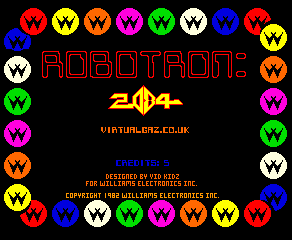 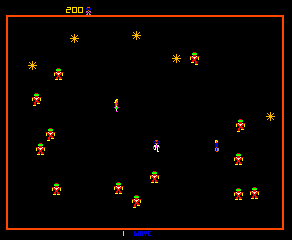 |
| ROBOTRON A Williams great introduced in 1981/2 with twin joysticks as controls. The battle was to save the last human family in 2084AD from being cloned by robots and yourself from being evaporated by an awesome line-up of enemies such as brains, grunts, hulks and enforcers. highly addictive gameplay and one which required the player to manipulate two joysticks for the very first time. "Robotron: 2084", to give it its correct title, pandered towards the specialist, as all Williams' games did, and some amazing scores in excess of 250,000,000 pts were talked about. Williams certainly knew how to create games which demanded player attention and these games still today hold a captive audience on the PC. |
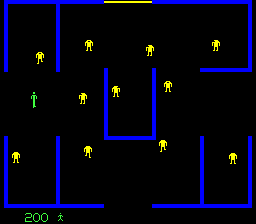 |
| BERZERK Stern Electronics issued Berzerk in late 1980. Sadly, most of the 25,000 machines ever made suffered at least one nervous breakdown and the hardware was nothing to write home about either. The joystick that worked didn't crop up very often on Berzerk and when you did locate a game in working order it was likely to reset in mid-credit! When it was going, it was an excellent piece of kit. Controlling a stick-like human around a maze of electrified walls and robots was made worse by digital taunts like "..chicken.....fight like a robot.." in this early talking classic. It all looked so easy until my coin went in. |
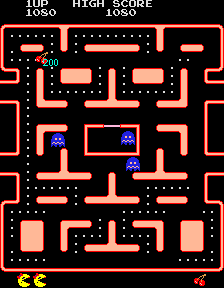 |
| Ms. PACMAN The first of many innovations to the famed theme, although I thought it should've been titled "Pacwoman" or at least "Pacgirl". Anyhow, another massive success from Bally / Midway with even harder mazes and even juicier fruits and goodies like pretzels as bonuses. The interludes between scenes were spiced up as well with titles like "They Meet" and "The Chase" concluding in "Pacman Junior"! It was all a little bit too sexy for a couple of fat yellow blobs really. Scores were bigger than the original but harder to come by making it as compelling as first time round. This time the rumours set around tricks were in the form of 'completing the 137th screen for 64 free credits' which would've been exactly what you didn't need after spending 2 hours getting there. |
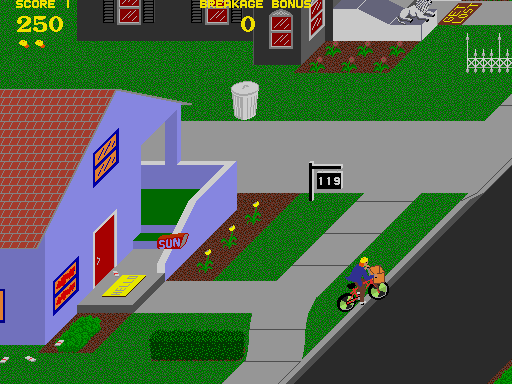 |
| PAPERBOY Forever coming up with markedly different themes from the mainstream variations, Atari enlisted a BMX riding paperboy for this 1985 masterpiece. Coming complete with handlebars, grips and a throw button each side, the player would have to weave at a slant up 'easy', 'medium' or 'hard' streets while chucking papers and avoiding the likes of manic skateboarders, trolley-pushing shoppers, evil cats and the odd swarm of bees! After negotiating the brawling neighbours, the stunt course at the end of each day seemed almost dreary. Designer Dave Ralston started out with giant snails and ducks by all accounts but off-loaded them in favour of reality (!). The gameplay and audio were compelling. Sometimes I'd find myself deliberately hurling the papers at windows and not the mailbox just to hear some of the wonderful phrases paperboy came out with. Smashing windows also earned points on certain houses (the ones who had cancelled their subscriptions) and as you collected more papers along the street, there became the goal for that ever-elusive perfect round where all the papers were delivered "Right in the mailbox!" and maximum bonuses achieved - all important as the game ended after Sunday's much heavier and bulkier deliveries:which required you to adjust your technique accordingly. The now common practice of limited game play did not, however, put paid to mega-games on Paperboy. Soon after the game hit the arcade floors a truly amazing fault was uncovered. News spread like wildfire about "the trick on Paperboy" and it became my ambition to visit every arcade housing the machine and carry out the trick. If you made Paperboy ride up the grass verge after completing an assault course on a standard difficulty machine, he would not in fact finish that day's work but magically regain his composure and be faced with a further two courses of incorrect colour and layout! Finishing that little lot without coming to harm made for a monster bonus handout. So massive was the pointage - usually around 1,700,000,000, that it hardly fitted on the screen! And when it came to putting your name up after this exhilarating feat of skill, it simply couldn't do it! Your three initials would overlap the score and maybe just as remarkably, the score was then reduced to 5,600,000+ points every time, give or take! Players everywhere became the first video billionaires of all time and with the dishing out of free lives galore while all this went on, a modification kit was said to have been issued by Atari which caused the score to reset back to zero if the trick was employed. |
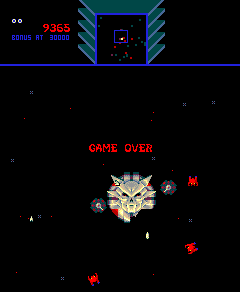 |
| SINISTAR As a quality outfit, Williams' had the knack of producing really great games - and Sinistar was no exception. But Williams' were outrageously underrepresented in UK arcades which meant that every title they released (except the smash hit Defender) achieved only cult status on the whole. Equipped with a variable-speed 49-way joystick, this was one of the scariest games I'd ever played. A true spine-tingler when the nasty 'Sinistar' himself came to life and made himself known by proclaiming "I live" and "Run coward, run". It was a haunting experience out there in deep space against this thing and chunky meteorites. For all its merits and now 'classic status' it's hard to believe I can count on one hand the Sinistar cabinets I've played on. |
  |
| LADY BUG A Ladybird in a maze full of revolving doors was the theme of this 1981 release by Universal. Avoid the enemy bugs, flip the doors and eat all the dots while collecting some unusual bonuses en route and the high score was all yours. It doesn't always work out that way though does it? Universal introduced many innovations in their games with this one sporting a skill related extra - the better you were, the more extra bugs you could earn - and a seemingly skill related free credit. By making up the word "SPECIAL" from the pills around the maze, you'd earn another game so long as the letters were eaten while red in colour. Of course there was a catch. In doing so you'd scoring more points but surrendering the 'E' and 'A' of the word "EXTRA" which quite probably would never appear again! It was the real "Hobson's choice". The until now standard fruit bonuses were replaced with more exotic fare such as 'horseradish', 'Chinese cabbage', 'sweet potato' and the unforgettable 'red peper' which was worth 8,000 points (but nil for spelling). Lady Bug's maximum score of 999,990 pts has never even been half met to my knowledge which is hardly surprising when the real speed kicks in around 200,000 pts. By spending countless hours messing with my own Lady Bug machine and the dip switches, it was found that the maximum of 255 screens became screen "0" on completion - with some very weird graphic corruption - and on inserting the 256th credit, the maze images are split and lifted by half an inch! |
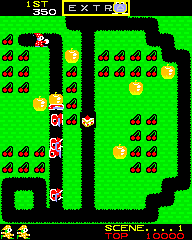 |
| Mr. DO! Another one of those games which was played at length all over the world. From little Cornish seafront arcades to the huge amusement halls of the US and in every other taverna in the Med., Universal's Mr. Do! made his first big-screen debut in 1982. These were the years when 'anything went' on the cathode monitor so it was of little surprise to find a small polka-dotted clown mining for cherries against dinosaurs with only the aid of a magic ball! True escapism and still a marvellous way to spend an hour. Universal's traits of providing free men for the skilful and free credits for the lucky were all here and better than ever. Do you go for the magnificent free game diamond and lose the points and extra bonuses for not finishing the card properly? - or leave the 8,000pt gem for ever? Fifteen years on, and I still haven't tired of the infinitely tactical subtleties required for to get a decent score on Mr. Do! The clown can surely lay claim to eating the most succulent array of bonuses ever devised on a game. Cakes, biscuits, wafers, ham and lettuce sandwiches, jelly, sundaes with a cherry on top, waffles, fried eggs, milk, cheeseburgers and even a knickerbockerglory were all scoffed in order to boost the tally. Universal's best ever game, set to the backdrop music of the "Can-Can", offered average scores and statistics throughout the whole escapade and over the thousands of credits I've played and watched only once did it let itself down - to the tune of the 610,000pts I earned while the easy first screen played over and over again never advancing to scene two! At the end of this epic 90 minute game I had earned a rare occurrence indeed - namely two free credits - and do you think I could leave them there? With still a few onlookers, joystick blisters and sweat on my brow I did it all again....only this time it righted itself and I was worth a mere 171,000pts! |
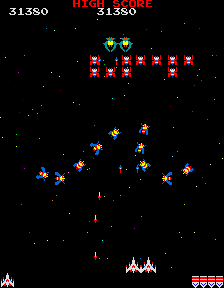 |
| GALAGA
For fans of Galaxian,
Galaga was a shot in the arm. This cloned
cousin of the great game was liberated way back in 1981 by Namco and
shot to the top of the videomeister's hit list. This time the bugs
really did fly and an attractor beam occasionally gave a showing to
kidnap your ship. Saving the abducted vessel meant that it was able to
team up with the present ship therefore doubling the firepower (and the
size of the target for the alien bugs) The Galaxianites were in their
element here with fast firing and a challenging wave to test the skill
and the memory and most importantly of all, to boost the score markedly
with no threat of being killed. No little red flags now - they'd all had
a make-over and been replaced by special ones denoting the waves by
permutation of 1, 5, 10, 20, 30 and 50 icons. The 50th one was something
special. It was a magnificent blue shield carrying a large white vee and
I still remember vividly the first one I ever saw. Galaga was a
statisticians dream showing the amount of shots fired and how many hits
you made and at last there was a way in which to enter your famous three
initials! It was only after hearing about a flaw in the
Galaga program that I became more
interested in playing it. The game was dominated by SJV at this time in
our arcade so it would've been futile to try and master it for me. After
the word got round that by leaving the bottom left bug until last on
stage one and letting it pass your ship for about 15 minutes, the
bullets he drops cease and then shooting him rendered the rest of your
game 'bullet-free', I immediately contacted SJV to put the plan into
action. He did the honours, sceptically at first, and then took it all
back when, after 8 minutes, the game became a bullet-free zone! The rest
was history and after 2 1/4 hours, the game freaked out on him and
reset! He had reached the end of the game: the 256th stage which has
strange effects on computer programs. SJV could only look on in horror
as the screen filled with machine code and the score was zeroed - after
amassing a mammoth 3,399,000pts.......first ship!!! Poor old Steve
didn't even get his name up for his troubles but at least all the
milestones had been surpassed.......999,990pts where the score 'clocks'
but leaves the hi-score so, the 100th stage which was signified by two
of those superb blue 'V' flags and eventually the 255th stage which was
completed to crash the game. And just for the record, the stats which
were flashed up for this memorable game were as follows: 15,497 BULLETS
FIRED 12,707 HITS 82% Hit/Miss Ratio That was the last time SJV ever
played Galaga back in 1985 but while in Australia in 1992, I had the
good fortune to come across a caravan site's games room containing a
1942 and Galaga.
Seeing them side by side memories of the great gamester at his peak so,
having a bit of spare time on my hands, I thought I'd put in a few hours
and try the trick. A couple of credits later and it was all flooding
back and I managed a million with the end score of '040,250' still
making the top of the day! I then began planning a marathon game with my
goal being 100 stages. The next few games yielded little more than six
figures but things were definitely not right with this bootlegged "Gallag".
The attract mode aliens began dropping erratically and their bullets
were upside down! Now I knew this was Oz but that was ridiculous. Over
the next two days bugs began to stick on the screen and I got
'game-overed' in mid-play every now and then. Exploiting the trick over
and over again had perhaps caused some serious program damage and, being
a real sucker for playing faulty games, this was right up my alley. Then
the next day it happened. Any video game player's dream. During a game
my score started scrolling up and up by itself! Two hundred thousand,
five hundred thousand, eight hundred thousand.......the trouble was that
it just didn't know when to stop! My ship could move and fire but there
were no bugs coming out to play and after the brief elation of seeing a
rolling score like that I realised that the game had locked up. The
number 9 is like a drug to me. It's the one which changes everything.
Ninety nine, nine hundred and ninety nine or just good old fashioned
nine, they're all the maximum of their class. The most. I love nine.
Transfixed, I watched the score repeatedly pass the 999,990 mark and
after 15 minutes or so yet another revelation: A blue number 'one'
appeared below the score! Unbelievable. I calculated that it
must have represented the one hundredth million and within a couple of
hours I was eagerly awaiting the 9digit to take its place. Would it be
replaced by a nought or a ten? The suspense was killing me. This was
it....here it came....another digit under that one! Amazing.
Before resetting itself, the score rolled on and on for another four-odd
hours ending up at a monstrous 2,560,000,000pts which was represented
thus : 000,000 5 2 Galaga '88 was released in 1987 (!) and became one of the few re-runs to better the original. A six-year gap in the industry is as good as twenty anywhere else and not surprisingly the end product was outstanding. ! |
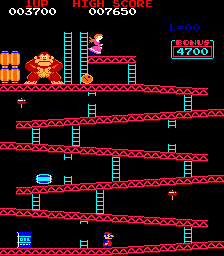  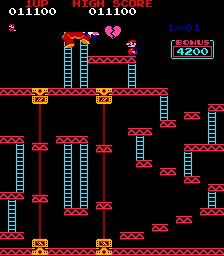 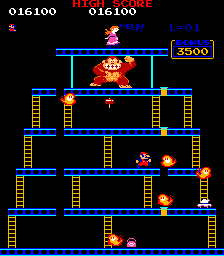 |
| DONKEY KONG It's hard to believe that Mario, the world famous video carpenter, made his first appearance way back in the dark ages of 1981. "Mario" and "Nintendo" are now household names of course and entered our everyday vocabulary many years ago but it was a different story in October '81. Mario was 1D for starters and only had a mallet at his disposal for self defence. Two versions of "Kong" (as it was largely known) were made - one for the Japanese market and the other for the U.S. and Europe. The former was quite different in layout and as a consequence, much easier on the novice because of the Japanese credit prices at that time. The copyists had yet another field day with Kong and there must have been over a dozen differing versions of play (and quality) in its heyday. The plump chippy never ever reached the princess in distress who was being held against her will by the giant King Kong type ape (not a donkey in sight). 'Don-kai' is apparently Japanese for 'mad' - hence the ridiculous Anglification of the name, whereas the widely used name of crazy Kong seemed a more logical choice. It was a building site theme of ladder climbing and barrel jumping in four differing scenarios culminating in a screen where Mario had to dismantle a scaffold structure to bring Kong to grief - only to have to start all over again! "How High Can You Try?" the dodgy translation asked at the start of every set of five screens supposedly being 5 metres high each, I think. Never had elevators and conveyers meant so much and my constant stream of credits during the early 80's uncovered some remarkable idiosyncrasies left by the programmers and forgers. The two best tricks which had plenty of shock value for the audience were the 'escape jump' and 'ladder pull' on cards one and two. On the first screen you needed to position Mario at the top of the first ladder in such a way that by pressing the jump button and moving the lever to the right simultaneously, he'd fly off the side of the structure to his apparent death. He never died! In fact he never hit the floor at all because he slipped down the side of the screen to the next level with an enormous bonus for his remaining time! The next screen also had a fault which allowed the player to earn another large time bonus. All that was required was to take Mario up the second ladder on the right hand side of the card and then pull him all the way down it again. On getting to the bottom of the ladder he'd just keep climbing down and down nothing and off the bottom of the screen......to the next level! The fault which put paid to my years of hard 'Konging' was the devastating discovery that after getting to the 12th level (shown as 'LEVEL 02') on my first man after more than an hour's graft, heading towards what I thought would be a world record (standing at 874,000pts in the US), the game logic wiped out all my remaining lives for no reason! This happened every time after that so rendering any scores in excess of 350,000pts on that version impossible. Doh! Mario went onto better things with arcading encores on 'Mario Bros.' and 'Super Mario Bros.' and is still appearing in millions of homes across the globe to this day, serving a new generation of screen devotees. |
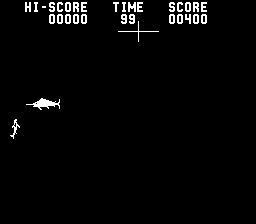
BLUE SHARK - |
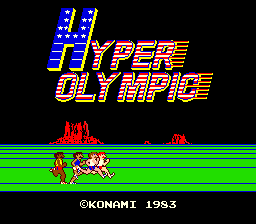 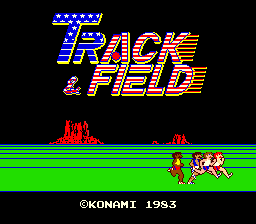 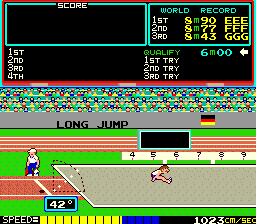 |
| TRACK and FIELD Many a bloody finger was the result of a vigorous session on this 1983 Konami game released in anticipation of the 1984 Olympic Games. The aim was to have your athlete exceed the qualifying distances for various disciplines like the 100m sprint, long and high jump and hurdles by the very fast tapping of two speed buttons and one for jumping. Impressive hand-eye coordination and lightning reflexes were the only way to a decent score and arcades everywhere started playing host to some of the oddest looking playing techniques ever. Theorising on how to speed up your athlete was rife around the game and a devout band of wrist, hand, finger and face contortionists grew rapidly. Indecent operators started to fit button shrouds to prevent players doing too well as the game freaks developed inhuman-like reflexes and by the time operators cottoned on to making the game harder but fitting it with a joystick, T&F or "Hyper Olympics" had an enormous following. When the joysticks were fitted they became a blur with unreal left to right manipulations and the World and Olympic records tumbled. Neither sets of controls could compare, though, to the ridiculous speeds obtained on a machine MPS and DOC played in London - it was fitted with a Missile Command roller-ball! Keeping the speed down now became a problem for the ball floggers and joystick thrashers. ROK and other exponents soon found out to their horror that a javelin throw more than 100m registered as "0"m and completely clearing the 10m long jump pit had the same effect! A copy game was easy to spot as I remember because the word 'height' was spelt 'hight' on the high jump round and another outlandish feature of the game was that the maximum score attainable was 9,999,900. This was only possible if the machine was set for continuing rounds and not limited to a single match, but the most I witnessed was a mere 5,500,000pts and noticed that the graphics went slightly astray after that magical 9th match. Incidentally, one of the rarest bonus chances ever installed in a video game (except those placed for programmers only) featured on the long jump round. Rumour had it that should all of your jumps be of exactly the same distance then a crocodile came out of the sand pit, gave 1,000 points and said "NICE"! |
 |
The operators and collectors bible Coin Slot was part of the World's Fair fortnightly newspaper. |
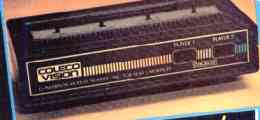 |
The controversial Coleco converter which could play Atari games. Lawsuits everywhere. |
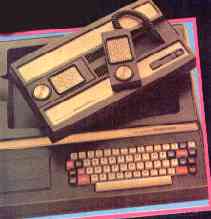 |
The fantastic Intellivision console with keyboard accessory. |
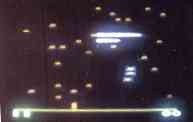 |
Atari VCS Centipede - nowhere near the arcade version |
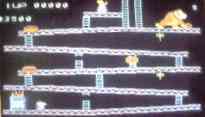 |
Colecovision Donkey Kong - a lot better than its rivals |
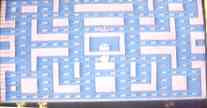 |
Atari VCS's Pacman - oh well! |
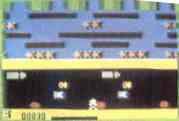 |
The best TV game player - Intellivision - it was almost twice the cost of the others! |
Lots more excerpts coming soon from GUS's historical and humorous book "GAME OVER GUS" (©1985-2004).